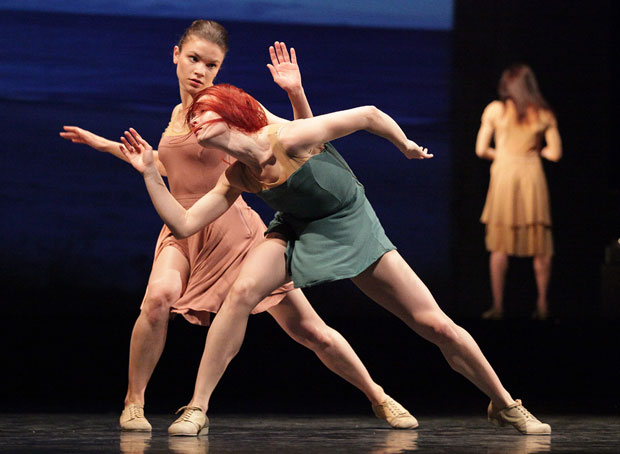
© Sebastian Cwikla. (Click image for larger version)
Baltic Dance Theatre
Windows, No More Play, Six Dances
Choreography: Izadora Weiss, Jiri Kylian
Baltic Opera, Gdansk
27 October 2012
www.baltyckiteatrtanca.pl
twitter.com/BalticDanceThea
Legend has it that Gdansk’s German name, Dantzig, originally stood for “Tanz ich,” that is “I dance.” It is little wonder, then, that the Polish city now plays host to a very ambitious young company, Baltic Dance Theatre, born four years ago from the ashes of a small ballet ensemble attached to the Baltic Opera. Directed by choreographer Izadora Weiss, it has built a repertoire of neoclassical and contemporary works from scratch, and its latest triple bill, performed at home in Gdansk at the end of October, shows it may have found a promising niche in Polish dance.
While many opera houses have suffered from a fraught relationship between their opera and dance components, Gdansk boasts a man-and-wife team at the helm. One of Marek Weiss’ conditions upon taking over the Baltic Opera was that he be allowed to refashion its fading ballet troupe into a more forward-looking dance company, and while the appointment of his wife, Izadora Weiss, at the helm of the ensemble didn’t sit well with everyone, it is no ego-trip: Weiss is a seriously talented choreographer with an affirmative vision for dance theater, and under her guidance the 20-strong ensemble has already come an impressive way.

© Sebastian Cwikla. (Click image for larger version)
Weiss trained as a ballet dancer in Warsaw and joined the Polish National Ballet upon graduation. Its traditional repertoire of Russian-inspired classics wasn’t quite enough for her, however, and she spent time trying to find her choreographic feet away from ballet. Opportunities came relatively fast: after several creations in Poland, Jiri Kylian invited her to be a “choreographic trainee” with Nederlands Dans Theater, where she gained experience alongside the company’s resident choreographers. She went on to choreograph for opera and dance troupes until the Baltic Sea came calling, and since her arrival in Gdansk she has produced a Romeo and Juliet (review), a Rite of Spring (review) and several abstract works to lay the foundation for BDT.
Her latest coup is the company premiere of two works by Jiri Kylian, and the resulting program, which had its premiere last May, is billed as an homage to him. Kylian offered to share it with one of Weiss’ own works, and the creation that opens the evening, Windows, readily acknowledges the influence of her mentor. A thoughtful, melancholy work, it is a fine introduction to both Kylian and the company, with hints of a voice and a musicality all Weiss’ own.
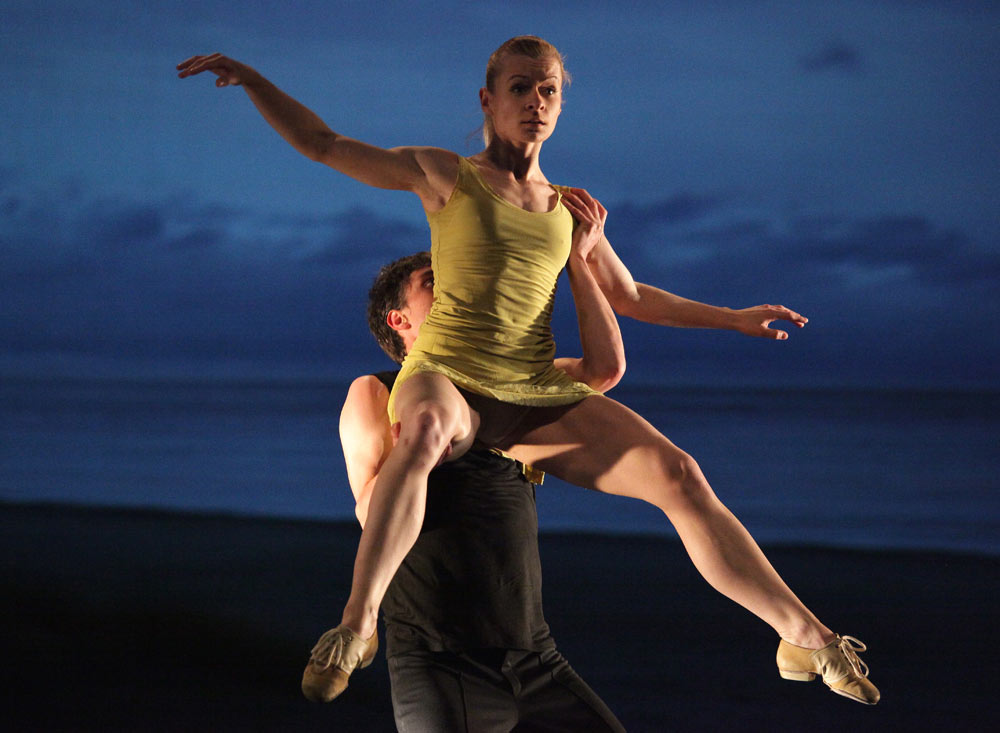
© Sebastian Cwikla. (Click image for larger version)
Windows starts with a woman alone upstage, engrossed in the sight of a beach landscape shown as a frame within the stage frame. The image turns sepia, then dark as the piece unfolds, and the woman seems to grow older with it, occasionally extending a hand towards some unreachable world beyond. With its muted colours and score, a mix of Leszek Możdżer, Mozart, Bach and Marin Marais, Windows is permeated by the nostalgic yearning the woman embodies; as the characters enter downstage, in duets or in groups, their relationships betray sad undertones, as if weighed down by the passing of time, and a restless anxiety shows in the brutal or defensive way they use their arms. When the lead character is drawn out of her reverie by a man, their pas de deux is fraught with tension, and soon she returns to the alluring landscape, arms folded around her as if for protection.
Windows goes back to the roots of Kylian’s style with very different results from NDT as we know it today. Choreographic references to the Czech master abound: deep, sculptural pliés, a similar fluidity through the body, partners’ reactions to each other and the visual counterpoints they create in pas de deux, low lifts with splayed, slightly bent limbs occasionally reminiscent of a praying mantis. Weiss’ dancers are not all classically trained, however, and rather than the sleek, stylish lines and visuals that seem to define NDT nowadays, Baltic Dance Theatre emphasizes modern lines and individual flow over unison and similarity, as if telling the story of a collection of individuals.
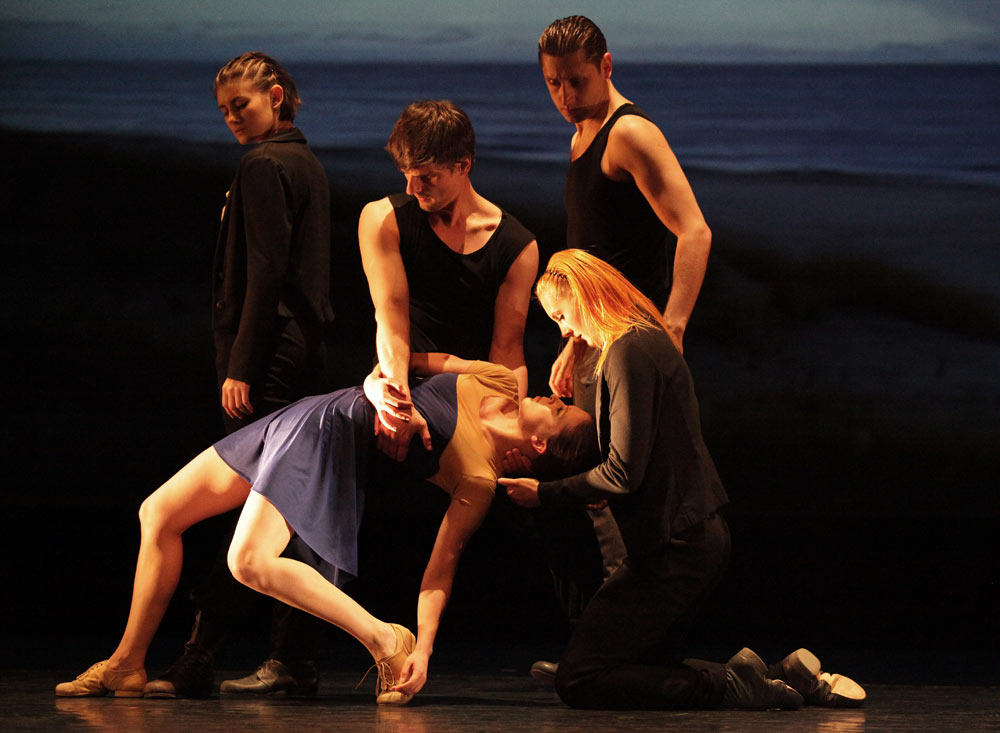
© Sebastian Cwikla. (Click image for larger version)
There is also an undercurrent of raw emotion to Weiss’ work, reflected in upper body work that eschews neoclassical grace for rougher angles and hints of tension in the shoulders. As in some of her other works, gender violence is inescapable: the Kylianesque flow of a pas de deux is regularly interrupted by a gesture of refusal on the woman’s side, and masculinity often emerges as a seemingly menacing force, all brutal invitations. Weiss’s take on gender is steeped in the Polish context, but the seamless choreographic results – women in suits, partnering work between women, a lesbian kiss – are a subtle reminder that the awareness it demonstrates is still not a given in any country.
And the company has mastered the art of implied narratives. While some scenes lack clarity, the last part of Windows brings together the entire cast to slowly weave the threads created throughout the piece: an ensemble movement building up in waves as some watch before joining in, a woman left out until the community scatters and a man remains with her, the lone character watching vicariously from the back, gesturing as if to mimic the dancers’ emotions. As pure-dance drama it is engrossing, a layered construction performed with absolute conviction and which holds out much promise.
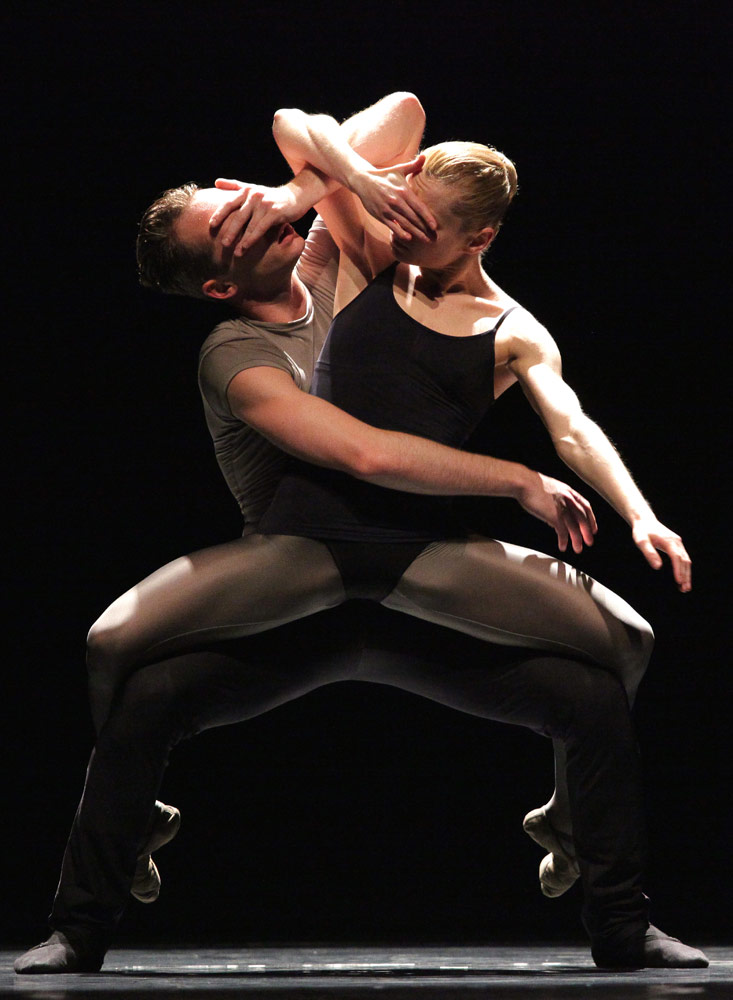
© Sebastian Cwikla. (Click image for larger version)
It is refreshing to see Jiri Kylian’s repertoire performed by a mostly modern company, and the two works of his that completed the programme were danced with an encouraging sense of theatrical flair. Both are part of the famed Black and White series, but No More Play explores more serious territory. As performed by BDT, its focus on dance as architecture was reminiscent of Balanchine’s Agon: both are set to spare, occasionally menacing, scores (for Kylian, by Anton Webern), and their choreographers certainly imply that they are playing no more in their strictly abstract response to the scores – unless the game happens on another level altogether, since Kylian cites a Giacometti sculpture representing a board game as inspiration for No More Play.
If his five dancers are playing anything, it must be chess, with black and white lighting drawing squares on to the stage. The choreography is all geometric austerity, with typical Kylian poses transformed to have the same impact as the pas de deux from Agon: women reclining on their partners and stretching arabesques for the sake of the visual, geometric effect, strikingly straight lines in an upside down lift, limbs manipulated and pushed to reach the point where a sense of (abstract) danger creeps in. Lifts straight from Petite Mort become marmoreal physical sculptures, stripped of their layers of emotion; the dancers retain the impassiveness of chess pieces as their trembling or pedalling feet break a classical pattern or as they lean over the edge of the stage, signalling the end. It’s the perfect abstract benchmark for the recurring choreographic themes in the Black and White series, and an uncompromising introduction to Kylian: BDT’s women, here in ballet slippers, performed with steely focus in a piece that puts more emphasis on classical technique than the rest of the program.
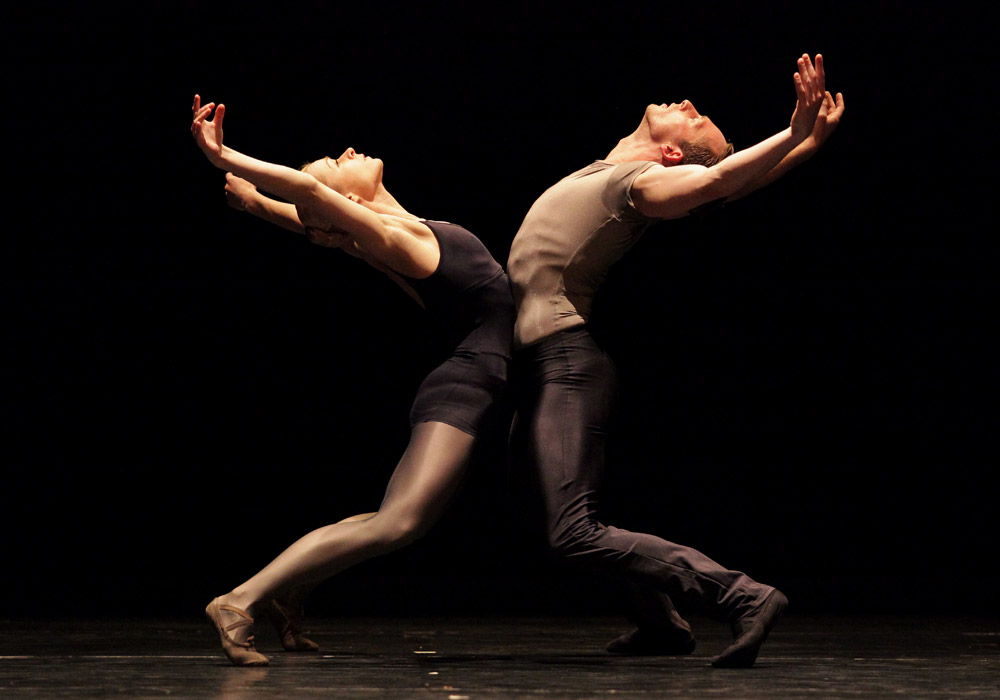
© Sebastian Cwikla. (Click image for larger version)
Kylian’s Six Dances rounded off the evening with a little comic relief. It took the Gdansk audience a few minutes to realize they had permission to laugh, but the atmosphere lightened up as soon as they did. The nutty aristocrats set in motion by Mozart and clad in what Kylian calls “Mozartian underwear” are perhaps the most eccentric characters in his repertoire, and their whimsical dances, chock-full of falls, entanglements and other physical and visual jokes, worked their charm in Poland as they do seemingly everywhere: the wigs spewing out white powder, in particular, are a moment worthy of the Trocks. It is Kylian as fantasist, a side of him we don’t see every day, and the way his musicality serves the wackiness of the characters is an absolute joy.
The dancers were slightly late to the party when the music started, but the piece lends itself surprisingly well to their full-bodied, modern way of moving: they go for some of the more grotesque moments with dynamic conviction and a clear sense of timing. All in all, the performance showed the company at its very best, despite some rough edges. The challenge now for Baltic Dance Theatre will be to keep raising their game with a repertoire that is still growing, but they certainly seem to have the right person to guide them in Izadora Weiss, whose own work might soon deserve international exposure.















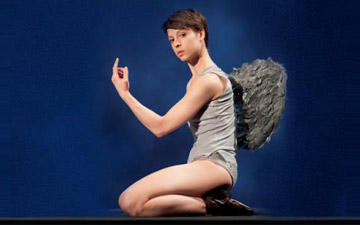

You must be logged in to post a comment.